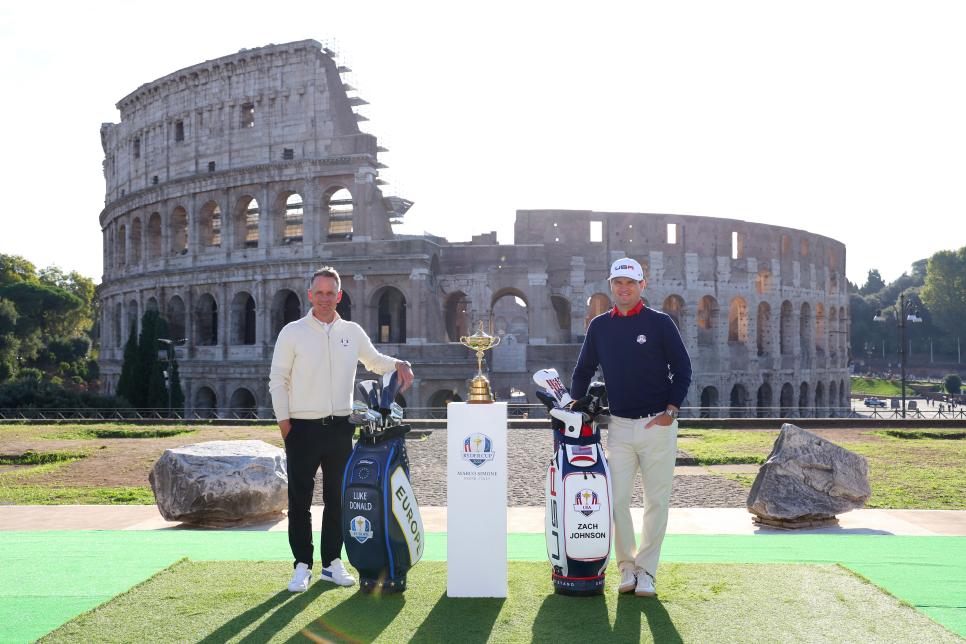[PHOTO: Carlos Amoedo]
When DP World Tour chief executive Keith Pelley and former European Ryder Cup director Richard Hills announced that Italy had won the bid to host the then-2022 edition, the visuals were easy to get behind. The Italians pitched luxurious Marco Simone Golf & Country Club and its perch overlooking Rome and the dome at St Peter’s Basilica as the host course, guaranteeing these matches will be one of the most photogenic in the history of the competition.
But drenching attendees (and the television audience) in culture is only one minor goal for the biennial event. The real motivator—even beyond winning the Cup—is brutally simple economics. Getting venue selection right might be the single most important decision European professional golf makes.
On the American side, the PGA of America controls the Ryder Cup and is the main beneficiary of tens of millions in annual profits from a $US440-million television deal with NBC. In Europe, the DP World Tour owns the biggest slice of the Ryder Cup entity that controls its side of the event, and the revenue that the matches generate is essentially the only thing that keeps the DP World Tour afloat. The Rome matches are forecast to generate more than $US540 million in revenue and $US13 million in profit for the DP World Tour. Given that the DP World Tour loses a reported $US2 million to $US12 million in a non-Ryder Cup year, it’s easy to see why the stakes are so high when picking a location.
How did this work for Italy and Marco Simone? Back in 2014, groups from Austria, Germany, Spain, Denmark, Portugal and Turkey joined Italy to bid for what was supposed to be the 2022 Ryder Cup (before COVID stutter-stepped the schedule by a year). Denmark, Portugal and Turkey dropped out early, leaving Italy, Germany, Spain and Austria to vie for a shot at an estimated $US250 million in direct economic impact that an event the size of the Ryder Cup has on a national economy. Italy’s bid mirrored the successful one Paris’ contingent laid out in 2010 and 2011 ahead of being awarded the 2018 Ryder Cup—an event centred on an iconic cultural capital, with a secondary goal of getting a venue ready for a future Olympic bid.

Also, Italy put cash on the table. Marco Simone’s owners, the House of Biagiotti fashion brand, promised a $US15-million renovation to the tournament course on the grounds of the ancient estate just 16 kilometres from Rome’s city centre. The Italian Golf Federation promised to bolster the prizemoney for the DP World Tour’s Italian Open by more than $US2 million annually and make more than $US20 million in direct payments to Ryder Cup Europe. That’s the cash that makes up the bulk of the Ryder Cup’s operating profit across this two-year cycle. The $US11 million Italy reportedly kicked in this year is a bigger revenue line item than all the projected merchandise sales for the event—which is expected to attract 50,000 fans a day. The other part of the proposal? Boilerplate language committing to investing in the grassroots game across Italy, which has about 100,000 players and 280 courses.
Who is Marco Simone and why is Italy’s Ryder Cup course named in his honour?
Italy won the bid, but it almost fell apart when political winds changed. By 2017, Rome had pulled out of the race to host the 2024 Summer Olympics because of the cost. At the same time, the Italian government cut the $US100 million it had committed to support the Ryder Cup. The COVID pandemic forced the entire Ryder Cup schedule to be bumped a year, and the extra time gave event organisers time to negotiate with the government and corporate sponsors to shore up the financials and keep the matches viable. By 2020, the DP World Tour had entered a partnership with the PGA Tour in which the PGA Tour became a minority investor in the DP World Tour’s media-development arm. That investment grew to 40 percent by 2022, and the infusion of the PGA Tour’s technical and business development punch has helped the Europeans expand how they sell the matches to the world.
The Tom Fazio II redesign re-opened in 2020 to modest reviews from players and spectators at the past two Italian Opens. The stage is now set for what might be the most Instagram-ready Ryder Cup in recent history. The 70,000-square-foot Marco Simone clubhouse—the largest in Europe—and ancient Roman villa overlooking the 18th green will be decked out in decadence. The 350-acre resort’s rolling terrain is perfect for spectators and easy to access from the heart of one of Europe’s oldest cities. If you can’t find a beautiful food selfie to take in Rome, you’re doing it wrong.
This article was originally published on golfdigest.com



